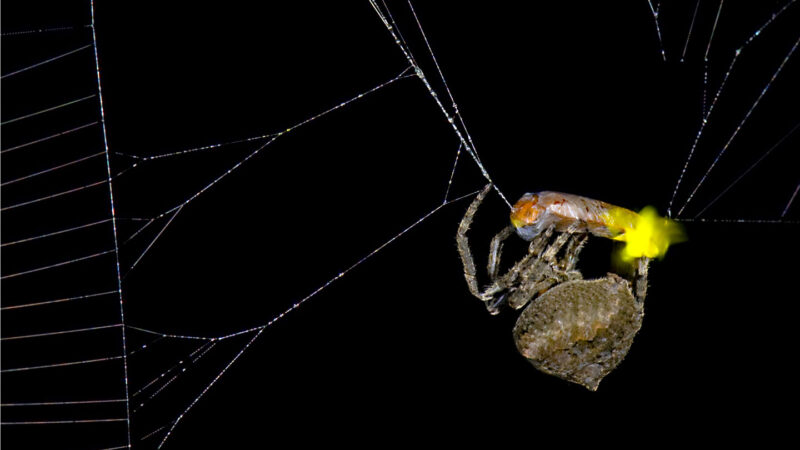Sometimes, fireflies shouldn’t follow the light. Especially when the web of an orb weaver spider is nearby.
Orb weaver spiders (Araneus ventricosus) can use trapped fireflies to lure in more prey. They seem to do this by tricking the fireflies into changing the pattern of their light flashes. That switch attracts even more fireflies to the spider’s web.
These findings appear in the August 19 Current Biology.
Explainer: Insects, arachnids and other arthropods
The firefly species that suffers this fate is Abscondita terminalis. It lives in tropical parts of Asia. Males have two lanterns. Females have just one. A single flash from a female usually helps male fireflies find her among tall grasses at dusk. Males are showier, giving off multiple light pulses to attract a mate.
But if stuck in the web of an orb weaver spider, flashy males can become deadly decoys. By making male fireflies blink in a pattern more like females, the spider now lures other firefly males into its web.
“What a cool behavior,” says Ximena Nelson. Though she did not take part in the new work, she does study animal behavior at the University of Canterbury. That’s in Christchurch, New Zealand. The new findings add a unique hunting hack to spiders’ skillsets, she says.
Work smarter, not harder
Researchers in Wuhan, China discovered the orb weaver spiders’ clever trick. The scientists did this by setting up cameras on the spiders’ webs in nearby farmland. Then they placed a firefly directly into the webs. In some cases, they removed the spider. Other times, the spider stayed.
Afterward, the researchers counted how many fireflies got caught in each web every few minutes.
Fireflies trapped in the webs of the orb weavers changed their flashes. Those in the webs of other spiders did not, explains Daiqin Li. He’s an ecologist at Hubei University who worked on the study.
When an orb weaver spider was around, male fireflies also were likely to get caught in its web and to change their flashing pattern. This was less likely when the spider was absent. These findings hint that something about the spiders affected the trapped fireflies’ flashes.
Further observations suggests that the fireflies’ altered flashing pattern helped orb weavers catch more prey.
To test this, Li’s team used black ink to paint over the lanterns of some caught fireflies. Without their prey flashing, orb weavers were now less likely to capture more fireflies.
Feminizing a male’s flash pattern
Orb weavers seemed to affect fireflies’ flashes in a very specific way. Trapped males that had been bitten and wrapped in a spider’s silk stopped using one of their lanterns to pulse light. Flashing just a single lantern, the males’ signal became weaker, single pulses of light.
These blinks appeared much closer to a female’s flash pattern. That gave Li’s team the idea that orb weavers make caught male fireflies look like females. This now coaxed more male prey into their webs.
Let’s learn about bioluminescence
The orb weavers also handled fireflies differently than non-flashing beetle species, Li reports. The spiders wrapped other beetles in a thick layer of silk. Then they almost immediately began to eat them. They wrapped the fireflies more lightly, leaving their lanterns still visible. Then the spiders stocked away the wrapped fireflies in their web.
As more fireflies get caught, Li says, the spiders “repeat the sequence for each of them — and leave them there, just flashing.”
Scientists still aren’t sure how exactly orb weavers change fireflies’ flashing patterns, Nelson says. Li suspects the spider’s bite or venom has something to do with it. He’s now planning to test those ideas. His team also plans to look for orb weavers outside of southeast Asia that might also use this tactic.




